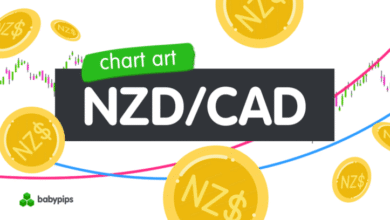
This week our currency strategists focused on Australia’s CPI Report for Q1 2025 and its potential impact on the Australian dollar for potential high-quality setups.
Out of the four scenario/price outlook discussions this week, one discussion arguably saw both fundie & technical arguments triggered to become potential candidates for a trade & risk management overlay.
Watchlists are price outlook & strategy discussions supported by both fundamental & technical analysis, a crucial step towards creating a high quality discretionary trade idea before working on a risk & trade management plan.
If you’d like to follow our “Watchlist” picks right when they are published throughout the week, you can subscribe to BabyPips Premium.
Check out our review on those discussions to see what happened!
EUR/AUD: Wednesday– April 30, 2025

EUR/AUD: 1-Hour Forex Chart by TradingView
On Monday, our strategists had their sights set on Australia’s Q1 2025 CPI report and its potential impact on the Australian dollar.
Based on our Event Guide, expectations were for quarterly CPI to jump from 0.2% q/q to 0.7% q/q, while yearly inflation might ease slightly from 2.4% to 2.2% y/y. With those expectations in mind, here’s what we were thinking:
The “Aussie Advance” Scenario:
If the CPI came in hotter than expected, we anticipated this could weigh against speculations of near-term interest rate cuts from the RBA, possibly giving the Aussie a boost against its counterparts.
We focused on AUD/CHF for potential long strategies if risk sentiment was positive, especially given the SNB’s recent dovish stance and plans to cut rates. The pair was hovering near 0.5275, which lined up with the 100 SMA, the Pivot Point, and the channel support.
In a risk-off environment, EUR/AUD shorts made sense given the stark contrast between Australia’s PMIs holding above the expansion line while Eurozone flash PMIs were in contraction territory.
The “Aussie Avalanche” Scenario:
If Australia’s inflation data disappointed, showing significant slowdown in price growth, we thought this could weaken the Aussie.
We considered AUD/CAD for potential short strategies in a broad risk-off environment, particularly as Canada just concluded its parliamentary elections, likely reinforcing its trade stance. With the White House conceding to softer auto tariffs, this could provide additional relief for the Canadian economy and Loonie.
If risk sentiment leaned negative, AUD/JPY looked promising for shorts given the pair was forming higher lows and higher highs inside a rising wedge pattern, with the Bank of Japan expected to deliver a “hawkish hold” announcement later that week.
What Actually Happened
Australia’s Q1 2025 inflation report delivered some surprises, showing more persistent price pressures than markets had anticipated.
The headline CPI held steady at 2.4% year-on-year, above the 2.2% forecast and matching the December quarter reading. More notably, quarterly inflation jumped significantly to 0.9%, well above both the 0.7% expected and the 0.2% recorded in the previous quarter.
Key points from the CPI report:
- The quarterly jump was largely driven by specific factors including a 16.3% rise in electricity prices as rebate programs expired, a seasonal 5.2% increase in education fees, and a 1.7% rise in housing costs led by rental prices
- Services inflation moderated to 3.7% annually from 4.3% in the December quarter, marking the lowest reading since June 2022
- Annual goods inflation increased to 1.3% from 0.8%, reflecting price increases in food and non-alcoholic beverages, which rose 3.2% year-on-year
- Trimmed mean (core) inflation eased to 2.9% annually from 3.3%, in line with expectations
The data showed the RBA’s inflation challenge remains, with headline inflation holding comfortably within their 2-3% target band but quarterly figures suggesting underlying pressures persist in certain sectors.
Market Reaction
This outcome fundamentally triggered our AUD bullish scenarios, and with risk sentiment leaning positive following improving U.S.-China trade relations, EUR/AUD became our focus.
Looking at the EUR/AUD chart, we can see the pair had been testing the triangle resistance before the data release, forming a consolidating just above the 200 SMA dynamic inflection point at the 1.7850 zone. The hotter-than-expected inflation report provided the catalyst needed to make a decisive bounce off the triangle top and a break below the 200 SMA.
Immediately following the CPI release, EUR/AUD fell through the Pivot Point at 1.7806. The pair continued its descent through the next trading session but bounced off the 1.7750 minor psychological mark before even testing the triangle bottom.
Although euro’s weakness against the Aussie was compounded by disappointing Eurozone PMI data earlier in the week, upbeat flash CPI readings from Germany and France later in the day triggered a sharp rebound for the shared currency, taking EUR/AUD back to the triangle resistance again.
Still, the pair was unable to get past its intraweek highs, resuming its slump on more reports that China was considering suspending more U.S. tariffs, providing additional support for the risk-sensitive AUD and ultimately triggering a break of the EUR/AUD triangle bottom.
By the end of the week, EUR/AUD had dipped to S1 (1.7595) near the 1.7600 major psychological level, which spurred a strong bounce enough to retest the broken triangle support before resuming its slide to the next floor at the 1.7550 handle.
The Verdict
So, how’d we do?
Our fundamental analysis correctly anticipated potential AUD strength on stronger inflation data, which materialized in the actual numbers. Our technical analysis also accurately identified the descending triangle pattern and potential breakdown levels below 1.7700, although the actual catalyst for a sustained drop came up much later on.
We think this discussion was “likely” supportive of a net positive outcome as both fundamental and technical triggers aligned well, but it was overall risk sentiment that took the pair to its target support levels. Hotter-than-expected Australian CPI provided the catalyst for drop below the triangle resistance, although some green shoots in the eurozone led to another test of the ceiling before a more prolonged slide towards the end of the week.
Traders who entered short positions around the triangle top before the CPI release or on a break below the pivot point level after actual numbers were printed could have captured a decent short-term gain until the 1.7750 minor psychological mark.
However, trade management would have played a crucial role in determining the outcome of the position, as the decline was not sustained until the triangle support target and instead saw a reversal back to the top in the succeeding trading sessions.
Adjustments to open positions like trailing stops to entry might have led to a breakeven result while keeping the trade open until the end of the week while overall risk sentiment remained supportive of the bias would have caught the larger move to S1 or the 1.7600 mark after the triangle support breakdown.
The key lesson here is how effectively a fundamental catalyst (Australia CPI) can confirm a technical pattern (descending triangle) that was already forming, allowing it to stay intact despite some mid-tier data surprises (upbeat eurozone CPI) along the way then eventually resulting in a directional move (triangle breakdown) as more market factors (improving trade discussions between U.S. and China) align.
Source link








